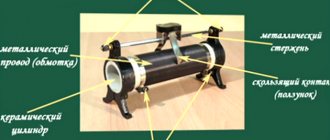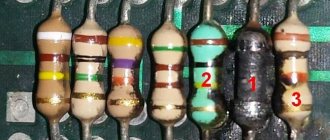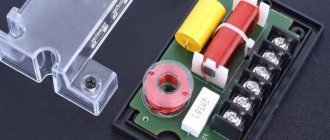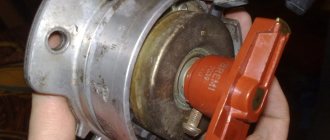Three main components of electric current
Electricity has become an integral part of our lives. It is used almost everywhere, including in vehicles.
This type of energy has three main components - voltage, current and resistance.
As for the last parameter, due to the possibility of creating additional resistance at any point in the electrical circuit, you can influence the first two parameters.
The main element for creating resistance is a resistor. This element is one of the most in demand, and not a single electrical circuit can do without it, and it will not be possible to replace it with anything else. And in any car there are plenty of electrical circuits.
Purpose
The main purpose of a resistor is to create resistance to be able to control and adjust the current and resistance. In fact, it is a kind of filter that allows you to obtain electricity with certain parameters at the output.
It provides all this by holding current, dividing and reducing voltage.
The main parameter of a resistor is the resistance it creates in the circuit, and it is measured in Ohms.
Resistors in the electrical circuit of a car.
It is precisely because of its function that this element is so often used in cars. Below we will look at some of the main components of a car, where a resistor is used and what specific function it performs there.
Cooling system
So, the load resistor is used in the car’s cooling system, or more precisely, in the radiator fan power circuit.
It is worth noting that previously this electrical element was not used in this circuit, and everything worked very simply - when a certain coolant temperature was reached, the temperature sensor closed the contacts of the fan power circuit, and it started working.
The use of a resistor made it possible to make the fan motor operate in two or even three modes.
The process of supplying power to the fan has changed somewhat. Relays have also been added to the system, and in modern cars the electronic control unit is already responsible for turning on the fan.
That is, the electronic unit analyzes the temperature readings of the sensor and sends a signal to the relay.
Depending on the temperature, the relay directs electricity through a specific circuit. If the coolant temperature is slightly exceeded, but it is already required to be reduced, and a signal from the ECU is received, the relay directs electricity through a load resistor, which creates resistance, and the fan begins to rotate at low speed.
If the temperature continues to rise and reaches a critical point, the relay will redirect the electricity through another circuit - bypassing the resistor, directly to the fan, which will ensure its operation at full power, with a high rotation speed.
This is a dual-mode fan operation circuit, which is ensured by the presence of a load resistor in the circuit. Moreover, it is simplified to make it more understandable.
In a car with three-mode fan operation, the principle remains the same, but it already uses two resistors - one is responsible for low fan speeds, the second for medium ones.
The third mode is emergency, in which the fan rotates at maximum speed, and is ensured by supplying power directly to it.
6. Removing and installing the heater fan and additional resistor
Heater block
| 1 – heater radiator; 2 – screw; 3 – air flow distribution box; 4 – executive motor of the “fresh/recirculated air” switching valve; 5 – screw; 6 – heater fan; | 7 – heater fan casing; 8 – screw; 9 – block of resistors with overheating protection; 10 – screw; 11 – lever of the central damper; 12 – damper lever that controls air temperature |
Removal
| EXECUTION ORDER |
| 1. Remove the glove box. |
| 2. Disconnect the electrical connectors from the auxiliary resistor (9). |
| 3. Disconnect the electrical connector from the heater fan (6). |
| 4. Unscrew the screw (10) and remove the additional resistor. |
| 5. Pull the heater fan down. |
Installation
| EXECUTION ORDER |
| 1. Install the heater fan. |
| 2. Install an additional resistor and secure with a screw. |
| 3. Connect the electrical connectors of the additional resistor and the heater fan. |
| 4. Install the glove box. |
Website design and development
After the expiration of copyright, in Russia this period is 50 years, the work becomes public domain. This circumstance allows you to freely use the work, while respecting personal non-property rights - the right of authorship, the right to a name, the right to protection from any distortion and the right to protect the author's reputation - since these rights are protected indefinitely.
© Auto manuals. All information presented on this site is the property of the project or other indicated authors.
Ignition system
The second element of the car where you can find a resistor is the spark plugs. But not all candles are equipped with it.
It began to appear in the design of these elements not so long ago, and its task is to suppress radio interference.
By the way, there is now a lot of debate about whether it is needed in candles. After all, the resistor creates resistance, which ultimately affects the spark. But the stronger the latter, the better the combustible mixture ignites.
But in fact, the presence of a resistor has a slight effect on the quality of the spark, but only positively on the spark plug. A very strong spark charge leads to the destruction of the electrodes, and the resistance reduces the spark voltage.
But this is not its main purpose. A powerful spark discharge creates quite strong interference in the radio frequency range, which can affect the operation of a car audio system, mobile phone and any other equipment that is sensitive to this type of interference.
Interestingly, it is not necessary to install spark plugs equipped with resistors on the car.
The fact is that in many models a noise-reducing element is installed in the tips of high-voltage wires. Also, some types of wires themselves have quite good resistance, which is enough to suppress radio interference.
The resistor can also be installed in the distributor slider, and it is found there on many models. Its task is the same as that of a spark plug or tip.
It is important to understand that resistors cannot be used simultaneously in all of the listed ignition elements.
When these elements are connected in series, all the resistance they create is summed up.
That is, if a resistor is installed in the distributor runner, tip, or spark plug, then they will create such a strong resistance that they will significantly weaken the spark charge, and it will no longer be able to properly ignite the mixture. And this will lead to interruptions in engine operation, loss of power, and increased fuel consumption.
Therefore, deciding whether to install spark plugs with a resistor on a car is necessary by carefully reading the technical documentation that comes with the car.
If the manufacturer indicates that the use of such candles is necessary, then it is better to use them.
If only fourth speed works
In cases where the motor refuses to work at the first, second and third speeds, but turns perfectly at the fourth, the same resistor with three isolated windings is to blame. If you can’t buy it, you can try to restore it yourself. True, only in the case when the thermal fuse has blown, naturally, no one will rewind the windings, the game is not worth the candle.
Fan resistor
You can remove and check the resistor without dismantling the engine. It's done like this :
- Use a Phillips screwdriver with a short blade to unscrew the rightmost screws securing the glove compartment.
Unscrew the rightmost screws securing the glove compartment.
Move the glove compartment aside to get to the resistor.
We remove the contact block.
Unscrew the screw securing the resistor.
Built-in fuse
To replace the built-in thermal fuse, any type KSD-160 or RY01-165 is suitable . They work up to a temperature of 150-165 degrees . To solder a new resistor, be sure to use low-melting solder so as not to overheat the part, and during soldering, hold it with thick pliers for better heat dissipation. Good luck to everyone and a comfortable temperature in the cabin!
Interior heating system
Another element in the design of a car where a resistor is used is the interior heating system, or more precisely, the control of the operation of the electric motor of the stove.
Every car uses a variable resistor to change the speed of the heater motor.
In it, using a rotating element, it is possible to change the resistance value.
When the electric motor is turned on to the 1st rotation speed, the resistor provides maximum resistance; when switching to the 2nd speed, it decreases, and when switching to the 3rd speed, it is almost completely removed.
How to replace
The algorithm for replacing the heater resistor is as follows: 1. It is necessary to remove the negative terminal from the battery; 2. Remove the lining, then the windshield frame trim, remove the upholstery for sound insulation; 3. It is also better to remove the vacuum booster for ease of repair; 4. Disconnect the block with wires located on the resistor; 5. In order not to accidentally replace a device that is still in good working order (after all, the reason may not be in it), it is worth checking it with an ohmmeter, connecting it to the contacts one by one. If there are significant differences from normal readings, then it is necessary to change; 6. To remove a faulty heater resistor, simply unscrew the screw and remove the damaged part; 7. Install the new one in reverse order. Please also note that the block with wires can only be connected in one position.
That's all - your VAZ 2110 can hit the road in cold weather. You will not freeze, and you will not experience inconvenience due to the increased operation of the stove.
A non-working heater fan, even in the warm season, can cause many unpleasant moments. For example, when it rains, the windows sweat in the absence of airflow. One of the reasons for the breakdown is a faulty resistor of the VAZ 2114 heater. In most cases, you can find and fix the problem yourself, without resorting to the services of car service specialists.
Lighting
Recently, resistors have begun to be used in conjunction with LED lamps. This type of lamps has increasingly begun to be used on cars.
But not all cars yet come from the factory equipped with LED lighting devices, but it is quite possible to buy them separately and install them instead of standard incandescent lamps for the same turn signals or brake lights, and many do so.
But here a problem arises that requires the use of resistors.
The fact is that the electricity consumption of these lamps is very small, which is why the electronic unit regards the operation of the LEDs as a malfunction of the standard lamp.
To correct the situation, resistors are used to create a load on the wiring lines that power those lighting fixtures in which LED lamps are installed.
As a result, the ECU perceives the resistance of the element as the work of an incandescent lamp, so no error code occurs.
It is interesting that when using such decoys, the main advantage of LED lamps - low energy consumption - is reduced to zero, and they have only one advantage over conventional incandescent lamps - a long service life.
Where is the resistor of the VAZ 2114 stove: diagram, photo
During the winter season, when the temperature outside is sub-zero, drivers turn on the stove to heat the interior. At the same time, the heating system on cars, including the VAZ-2114, consists of several components and elements. Accordingly, sometimes some of them fail during operation - for one reason or another. The heater must work normally in winter - driver discomfort behind the wheel often becomes the cause of various types of accidents on the roads. Therefore, there is no need to delay troubleshooting.
Features of the VAZ-2114 heating system
First, let's outline how the “fourteenth” stove works. Everything here is quite simple - exactly the same as on the predecessor of the VAZ-2114 - the “nine”. Here are the main details of the heating system of the “fourteenth”:
- radiator;
- faucet;
- fan;
- switch that regulates air flow.
As you can see, there really is nothing complicated here. Warm air is supplied to the cabin through special dampers. In this case, the power of the fan is controlled using a special resistor. Problems with it lead to the fact that the stove does not work in the first and second positions of the switch.
Types of resistors, their features
Of the resistors described above that are used in the design of a car, two types can be noted - load, they are also constant and variable. In general, these are two main types that have fairly wide application in various fields.
Of course, there is a whole range of different resistors that differ in their design features. For example, thermistors, in which the resistance changes with temperature, or photoresistors, which change their parameters depending on the illumination. But we will not touch on them for now, but will consider only the two types indicated.
Fixed resistors are so called because the resistance they create is constant.
For example, if it is indicated that the main parameter of a given element is 30 Ohms, then it provides the resistance of exactly this value and it is impossible to change it.
In variable resistors, the resistance can be changed, manually. An example of this is the already mentioned control of the electric motor of the heating system.
Variable resistors also include trimmers.
In such resistors, you can also change the parameter manually, but its adjustment is not performed at any time, as is done in a variable one, but only when it is necessary to reconfigure the operation of the entire circuit in which it is included for a long period.
Trimmers are not used in vehicles, although they can often be found in household appliances.
Replacement and modification of the stove
If there is a poor supply of warm air due to the fault of the air duct, a small modernization of the VAZ stove and air channels suggests itself. Thus, heaters 2112-01 and 2112-02 proved to be quite effective. Independent adjustment and fine-tuning of the VAZ stove will provide the necessary comfort.
The heater was turned on at first speed and when I started it, apparently all the energy was spent to start the engine, but the heater motor did not start. As a result, the heater heater resistor burned out. I turned on the 4th one, it works. Just don’t turn it on immediately without pushing it into place under the glove compartment, it will melt without blowing. The Gazelle's heater resistor is very similar to ours, but it is three-pin and instead of a thermal fuse, some large black square piece is soldered in there. Do you think my resistor block is similar and the problem is most likely the same? As for the question, I recommend looking for self-healing thermal fuses based on bimetal.
I have changed such thermal fuses more than once in different devices. That is, it is disposable. Why is it needed then, to protect the stove body from melting? What type of heater motor does the VAZ 2112 2004 have, new or old? The fourth speed did not work because ring cracks appeared along the solder in the SAUO block. I soldered it and everything started working. The measurements on the removed heater engine 2111 were so memorable.
The stove system has 2 dampers. Breakdowns of the stove damper can be of different types; firstly, the damper often gets stuck or jams, and secondly, the damper drive (micromotor-reducer) fails. Therefore, if you cannot hear the damper moving, you can move it by hand by removing the deflector in the central panel.
Selecting a resistor by resistance
Most people, when an electrical appliance fails, send it in for repair or replace it, although in many cases it is the resistor that is to blame, especially since it is one of the most common elements in any circuit. But there are also those who undertake repairs on their own.
And often DIY repair enthusiasts have a question about how to choose the right resistor for a particular circuit.
To do this, let's take the simplest circuit, including a power source and one consumer.
Even at the beginning, it was indicated that electricity has three main characteristics - voltage, current and resistance. It is based on these parameters that all the necessary calculations are made using Ohm’s law.
According to this law, since we need to determine resistance, we should divide the voltage by the current.
For example, our power supply provides a 12 V circuit with a current of 0.02 A.
To determine the resistance, we carry out mathematical calculations - 12/0.02 and get a circuit resistance of 600 Ohms.
Now directly about how to calculate the resistance of a resistor for use in a particular circuit. For example, let's take a 12 V power source and a consumer (3.5 V incandescent lamp, 0.28 A).
First, the lamp resistance is calculated - 3.5/0.28 = 12.5 Ohms. Now we find out how much current will flow through the existing lamp - to do this, take the voltage of the power source and divide by the resistance: 12/12.5 = 0.96 A, which is 3.5 times the current required for the consumer to operate, and if you connect consumer, then the lamp filament will simply burn out.
To prevent burnout from occurring, a resistance in the circuit of 43.75 Ohms (12.5 * 3.5) is required. And since the lamp itself creates resistance, an additional 30 Ohm resistor must be connected to the circuit. During the calculations, we get - 12 V / 42.5 Ohm (lamp and resistor resistance) = 0.28 A.
That is, we received the current strength necessary for normal operation of the consumer. In this case, the element included in the circuit acted as a current limiter.
Device elements
The stove on the VAZ-2106 includes the following main components:
- deflectors;
- stove tap rods;
- air intake covers;
- windshield air ducts;
- radiator;
- radiator casing;
- outlet pipes;
- underwater;
- stove tap;
- air distributor cover;
- electric fan motor;
- fan impeller;
- additional resistors;
- air ducts of the internal ventilation system;
- distributor cap lever;
- brackets;
- lid control handle;
- crane control handle;
- draft of the air supply cover.
These elements represent a heater device on a VAZ-2106 car.
Design and operating principle
The cabin heater on the VAZ-2106 car is a compact unit, the main components of which include:
- stove motor;
- fan with impeller;
- radiator;
- damper for air flow distribution;
- stove faucet with control levers.
IMPORTANT! If leaks were found in the radiator circuit of the VAZ-2106 stove, then, if possible, replace the radiator with a new one. Its repair is complex, plus it does not always bring positive results.
This is more of a temporary measure.
The design of the stove on the VAZ-2106 car is quite simple, but for beginners, coping with the tasks of repairing it may be an impossible task. This is wrong. Especially if you are familiar with the device and design features of the heater.
- The standard, that is, factory heater for the VAZ-2106, has a relatively compact size, but effectively cools the liquid and warms up the interior. This is noted by many owners of domestic classics. Switching on and control is intuitive.
- The VAZ-2106 uses the most common heating system design among the Russian automobile industry, and in some places even the Soviet one. The basis is the liquid cooling system of the main engine.
- The main elements of the heating system are the stove, connections to control elements (faucets, levers), lines and a radiator.
- The heater dampers and valve are connected to the control device using an elastic and flexible rod.
- When the upper element is moved to the upper limit position, the valve opens completely, which ensures the maximum amount of coolant entering the heating system through the radiator.
- If the lower control device is moved to a similar position, then the air intake damper will be open to the limit. This way, maximum air flow will be directed through the stove into the heating system.
- Deflectors made of plastic can change the airflow angle in the VAZ-2106 cabin. Thus, the driver and front passenger regulate the direction of the air flows created during heating or normal ventilation.
- The air distribution cover is not connected to the heater control system switch. This damper allows you to adjust the degree of closing or opening using a lever device. This design provides additional comfort to the driver of the VAZ-2106 when regulating the operation of the heating system.
- The device includes a three-position toggle switch designed to regulate the volume of air flow passing through the stove. The regulator allows you to choose between two ranges of rotation of the heater fan - from minimum to maximum.
IMPORTANT! Never turn on the electric heater fan if the air intake damper is in the retracted position and the valve is open
Features of connecting the stove
The VAZ-2106 uses the Me 255 electric motor. This is a direct current electric motor that is excited by a permanent magnet. Several nuances of the VAZ-2106 heater connection diagram:
- When an additional resistor is connected to the electric motor supply circuit, the armature shaft begins to rotate, but at a lower frequency.
- The resistor is secured with a pair of spring washers inside the heater fan casing.
- At a temperature of 20 degrees, the resistor resistance is 1.5 ohms.
- If the electric motor fails, it should be replaced;
- Repair consists only of cleaning the commutator or applying lubricant to the bearings.
- Normally, the nominal voltage parameters in the circuit are 1 V.
- Rated power indicators - 2 W.
- The rotational speed of the electric motor shaft is 3000 rpm (under 12 V voltage conditions).
The heating equipment is relatively simple in its design and design, which is why most VAZ-2106 car owners prefer to carry out repairs themselves.











